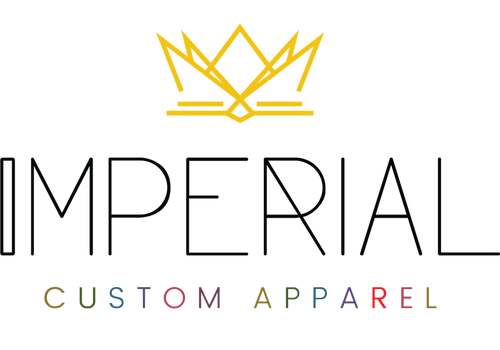File types for direct to garment printing
Design Guide for Imperial Custom Apparel
Welcome to Imperial Custom Apparel's Design Guide! Our goal is to help you prepare your designs for optimal printing or embroidery results. Whether you choose DTG Printing, screen Printing, embroidery, or bling, understanding the right file types, sizes, and formats is crucial for a flawless final product.
1. DTG Printing:
- Best File Types: For DTG printing, high-resolution PNG or TIFF files are ideal. These formats support transparency and are best for detailed, multi-colored, or gradient designs.
- Optimal Size and Resolution: Aim for a resolution of at least 300 DPI. The maximum print size is typically around 14 inches x 16 inches, but this can vary.
- Design Tips: Ensure your design is set against a transparent background if it doesn’t cover the entire print area. Also, consider the color of the garment, as it can influence the appearance of your print.
2. Screen Printing:
- Best File Types: Vector files such as AI, EPS, or high-resolution PDFs are preferred for screen printing. These files allow for cleaner separations of colors and better scalability.
- Optimal Size and Resolution: Like DTG, aim for a resolution of 300 DPI. The maximum print size for screen printing is usually about 15 inches x 17 inches.
- Design Tips: Simplify your design to use fewer colors for better results and cost-effectiveness. Screen printing is ideal for bulk orders due to its setup process.
3. Embroidery:
- File Types and Digitization: Embroidery requires digitized files, typically in formats like DST, EMB, or PES. Digitization converts your design into a format that embroidery machines can read, detailing each stitch and color change.
- Why Digitization? Embroidery machines don't understand standard image files. Digitization tells the machine precisely where to place each stitch, ensuring the design is accurately replicated.
- Digitization Fee: If your artwork isn't already digitized, we offer digitization services. The fee depends on the complexity of the design and the number of stitches required. This is a one-time fee, meaning once your design is digitized, it can be used repeatedly without additional costs.
- Design Tips: Keep in mind that extremely detailed or small text may not be legible when embroidered. Simplify your design for clarity and impact.
4. Bling:
- Design Preparation: For bling designs, vector files are also preferred. They should be simple enough to translate into stone placement while maintaining the integrity of the design.
- Design Tips: Consider the size and placement of bling elements. They should complement the garment and be practical for wear.
General Tips for All Services:
- Check your design for any spelling errors or design flaws.
- Ensure that you have the rights or permission to use any images or logos.
- Remember, the quality of the print or embroidery is directly related to the quality of the file you submit.
By following these guidelines, your designs will be well-prepared for our printing and embroidery processes. If you have any questions or need assistance, our team at Imperial Custom Apparel is always here to help. Let's create something amazing together!


Use left/right arrows to navigate the slideshow or swipe left/right if using a mobile device

